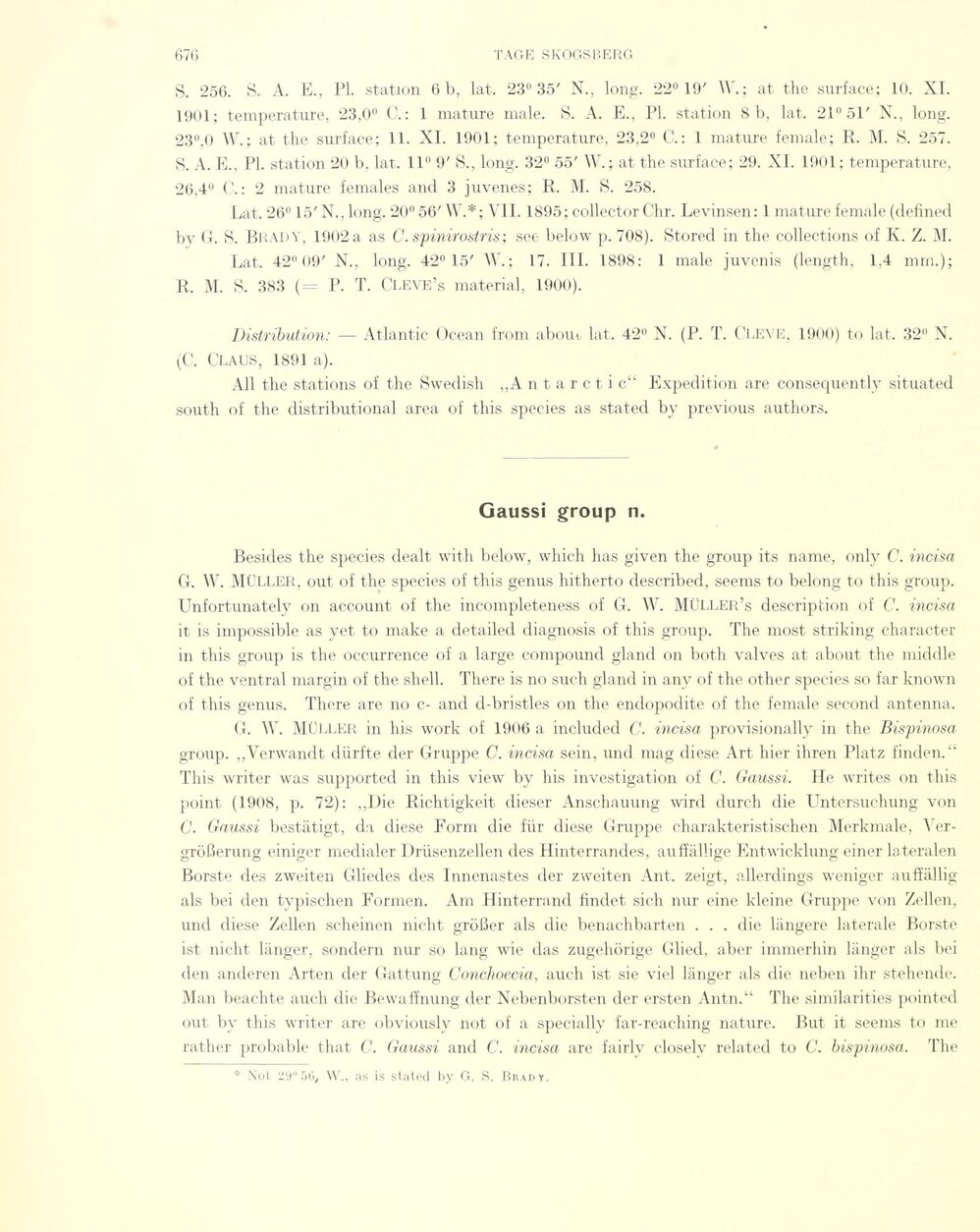
Full resolution (JPEG) - On this page / på denna sida - Sidor ...

<< prev. page << föreg. sida << >> nästa sida >> next page >>
Below is the raw OCR text
from the above scanned image.
Do you see an error? Proofread the page now!
Här nedan syns maskintolkade texten från faksimilbilden ovan.
Ser du något fel? Korrekturläs sidan nu!
This page has never been proofread. / Denna sida har aldrig korrekturlästs.
S. 256. S. A. E., PL station 6 b, lat. 23° 35’ N., long. 22° 19’ \Y. ; at the surface; 10. XI.
1901; temperature, 23,0° C. : 1 mature male. S. A. E., PL station 8 b, lat. 21° 51’ N., long.
23°,0 W. ; at the surface; 11. XI. 1901; temperature, 23,2° C. : 1 mature female; R. M. S. 257.
8. A. E., PI. station 20 b. lat. lln 9’ 8., long. 32° 55’ W.; at the surface; 29. XI. 1901; temperature,
26.4° C. : 2 mature females and 3 juvenes; R. M. 8. 258.
Lat. 26" 15’ N., long. 20° 56’ IV.*; VII. 1895; collector Chr. Levinsen: 1 mature female (defined
by G. S. Brada’, 1902 a as C.spinirostris-, see below p. 708). Stored in the collections of K. Z. M.
Lat. 42° 09’ N., long. 42° 15’ W.; 17. III. 1898: 1 male juvenis (length, 1,4 mm.);
R. M. S. 383 (= P. T. Cleve’s material, 1900).
Distribution: — Atlantic Ocean from about lat. 42° N. (P. T. CLEVE, 1900) to lat. 32" N.
(C. Claus, 1891 a).
Ail the stations of the Swedish ,,A n t a r c t i c“ Expedition are consequently situated
south of the distributional area of this species as stated by previous authors.
Gaussi group n.
Besides the species dealt with below, which has given the group its name, only C. incisa
G. W. MÜLLER, out of the species of this genus hitherto described, seems to belong to this group.
Unfortunately on account of the incompleteness of G. W. Müller’s description of C. incisa
it is impossible as yet to make a detailed diagnosis of this group. The most striking character
in this group is the occurrence of a large compound gland on both valves at about the middle
of the ventral margin of the shell. There is no such gland in any of the other species so far known
of this genus. There are no c- and d-bristles on the endopodite of the female second antenna.
G. W. Müller in his work of 1906 a included C. incisa provisionally in the Bispinosa
group. „Verwandt dürfte der Gruppe C. incisa sein, und mag diese Art hier ihren Platz finden.“
This writer was supported in this view by his investigation of C. Gaussi. He writes on this
point (1908, p. 72): „Die Richtigkeit dieser Anschauung wird durch die Untersuchung von
C. Gaussi bestätigt, da diese Form die für diese Gruppe charakteristischen Merkmale,
Vergrößerung einiger medialer Drüsenzellen des Hinterrandes, auffällige Entwicklung einer lateralen
Borste des zweiten Gliedes des Innenastes der zweiten Ant. zeigt, allerdings weniger auffällig
als bei den typischen Formen. Am Hinterrand findet sich nur eine kleine Gruppe von Zellen,
und diese Zellen scheinen nicht größer als die benachbarten . . . die längere laterale Borste
ist nicht länger, sondern nur so lang wie das zugehörige Glied, aber immerhin länger als bei
den anderen Arten der Gattung Conchoecia, auch ist sie viel länger als die neben ihr stehende.
Man beachte auch die Bewaffnung der Nebenborsten der ersten Antn.“ The similarities pointed
out by this writer are obviously not of a specially far-reaching nature. But it seems to me
rather probable that C. Gaussi and C. incisa are fairly closelv related to C. bispinosa. The
* Xot. 29" 56, W., as is stated by G. S. Brady.
<< prev. page << föreg. sida << >> nästa sida >> next page >>